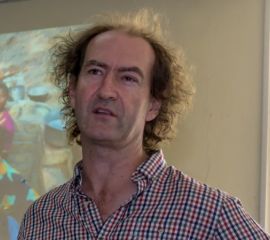Listen here on Spotify | Listen here on Apple Podcast
Episode recorded July 14, 2023
Episode released on November 2, 2023
 Laurence Gill is a Professor in Environmental Engineering in the School of Engineering in Trinity College Dublin. His research interests focus on water pollution, fingerprinting sources from human and animal waste, ecohydrology of wetlands and monitoring and modeling karst systems.
Laurence Gill is a Professor in Environmental Engineering in the School of Engineering in Trinity College Dublin. His research interests focus on water pollution, fingerprinting sources from human and animal waste, ecohydrology of wetlands and monitoring and modeling karst systems.
Highlights | Transcript
- Ireland is rich in water with rainfall ranging from 750 – 1250 mm/yr (30 – 50 inches), 85,000 km mapped rivers, 12,000 lakes but the quality of the water is poor in many placed. An EPA report indicates that 40% of river sites have elevated nitrogen levels and rivers, groundwater and estuaries in the southeast are under high pressure from intensive agriculture.
- There is a conflict between the agricultural sector wanting to increase agricultural productivity, e.g., Food Harvest 2020 and Food Wise 2025 programs and environmental concerns related to nutrient loading. Agricultural exports represent 80% of total exports ($9.5 billion [Bn] out of total of $12 Bn). Similar issues reported in the Netherlands and neighboring countries.
- Septic tanks represent another important source of pollution with population of 5 million in the Republic of Ireland and a third of population relying on onsite wastewater treatment, 85% of those relying on septic systems.
- Governance: EU Water Framework Directive passed in 2000, requiring all water bodies to achieve good ecological and water quality status by 2027 (ecological and chemical status of surface water and chemical and quantitative status of groundwater). River Basin Management Plans, 6 yr cycles. Dominant pollution source agriculture followed by septic tanks. No history of heavy industrial pollution in Ireland.
- Water Framework Directive: Phase 1: scoping; Phase 2, problem extent and solutions; Phase 3, success of solution strategies. Success stories limited.
- Farms small, difficult to govern, younger generation of farmers better educated and more environmentally focused. Small farms good for biodiversity, hedges, etc. Riparian buffer strips to reduce nutrient pollution in surface water.
- Expansion of industrial forestry in last 20 years, increasing sediment loading.
- Pollution from septic tanks partially controlled by soils (Knappe et al., 2020):
- heavily glaciated soils in northern half of country, low permeability, runoff directly to streams.
- high permeability soils in southeast Ireland, percolates too fast into underlying aquifers. Using willow trees to increase evaporation and reduce percolation (Curneen & Gill, 2016).
- Pollution source: animals or humans, human waste more critical from health perspective.
- Fingerprinting sources of pollution: E. Coli and nitrates can come from both animals and humans.
- Caffeine, pharmaceuticals, artificial sweeteners, fecal sterols linked to human waste.
- Fluorescent whitening, detergent.
- DNA sequencing, microorganisms human or animal sources.
- Irish Water (Uisce Eireann) created in 2013. Charging for water, only lasted less than one year. Now charge indirectly through central taxation. Lack of charging results in under-funded water sector.
- Many parts of Ireland subjected to severe flooding:
- Fluvial flooding, flash flooding, rapid
- Groundwater flooding, rising water tables, slow flooding but persists for much longer
- Lowland karst areas, ephemeral lakes called turloughs, full in winter and dry in summer.
- South Galway, long-term flooding, flood alleviation scheme using overland bypass channels.
Morrissey et al., 2020 ; Morrissey et al., 2021.
- Groundwater also connected to energy production, heat pump wells, 20 in front of Museum Bldg. in Trinity College, 22 wells, 180 m deep, used for heating tow large accommodation buildings, closed loop geothermal systems.
- Turf was used extensively for energy in Ireland, sphagnum moss that accumulated over 10,000 yr.
- Bord na Mona: industrial harvesting of turf in the Midlands, accounted for up to 40% of electricity in 1940s now about 8% in last 10 -15 years. Being phased out.
- Bord na Mona converted to Peatlands Climate Action Scheme, using existing workforce to enhance sphagnum moss accumulation by flooding regions and controlling water budget.
Swenson et al., 2019 ; Swenson et al., 2020.
- Linking science with the arts through music. Laurence Gill developed lyrics and others developed music to represent rain falling onto the land, how it percolates down through the soil, through epikarst, down into the caves, getting faster and faster, joining up together and eventually coming out in a spring somewhere.
- Inception Horizon performed at the Museum Bldg. in Trinity on day before Covid lockdown and then in caves in Slovenia.
- Film developed and ranked third in UNESCO Futures Festival.
- Optimistic about future: lot of tools, data analytics (AI, Machine Learning), solution focus, engineering and nature based solutions.
Examples of recent research using contemporary tools to gain insights and develop solutions.
Molecular sequencing, Remote sensing (nested drone satellite approach), and Machine Learning (flooding in lowland karst).



